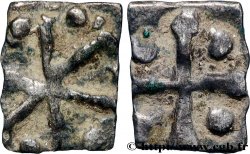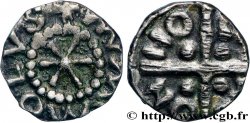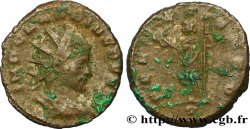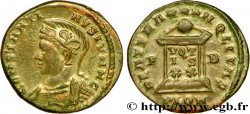v41_1639 - CHALON - SUR - SAÔNE (CABILONNUM) Denier à la croix
MONNAIES 41 (2009)
Начальная цена : 380.00 €
Назначить цену : 600.00 €
Цена реализации : 380.00 €
Начальная цена : 380.00 €
Назначить цену : 600.00 €
Цена реализации : 380.00 €
Тип Denier à la croix
Дата: (VIIIe siècle)
Монетный двор / Город: 71 - Chalon-sur-Saône
Металл: silver
Диаметр: 12 mm
Вес: 0,99 g.
Редкость: R2
Комментарии о состоянии
Monnaie sur un flan un peu court, mais avec les types complets et même une bonne partie du grènetis du droit. Patine sombre et crouteuse dans les champs alors que les motifs sont sombre et brillants
Ссылки в каталоге: :
Лицевая сторона
Аверс: легенда: ANÉPIGRAPHE.
Аверс: описание: Croix à six branches dans un grènetis.
Обратная сторона
Реверс: легенда: ANÉPIGRAPHE.
Реверс: Описание: Croix cantonnée d’un globule dans chaque canton.
Комментарий
Cette monnaie de cuivre ou de billon illustre l’ultime dégénérescence du monnayage de Chalon, avec la conservation des types de droit et de revers, mais sur un flan vil et sans légende. Cette monnaie correspond au n° 149 de l’étude de Ponton d’Amécourt. Ce type pourtant bien particulier n’est même pas repris dans le Belfort.
Il est intéressant de noter qu’une monnaie de ce type, mais d’un poids inférieur, a été retenue par M. Dhénin et P. Schiesser (RN 2007, n° 10 page 287) comme obole.
Tous les deniers de Chalon dérivent du bronze TEVDEBERTE / CA-BI-LON-NV (cf. Ponton d'Amécourt, pl. VI, n° 132) attribué à Théodebert Ier. La croix à six branches est considérée par certains comme étant un chrisme. Les deniers épigraphes de Chalon sont classés selon le nom inscrit au droit ; BADOINVS, MVMMOLVS, MAROL, BIL...INVS, ABBO, NERTVNVS, INPORTVNVS ou BOBO. Mis à part cette inscription du droit, l'évolution de l'épigraphie CABILONNO, au revers, permet de proposer une datation relative. La chronologie proposée par Ponton d'Amécourt est la suivante ; CA BI LON NV, CA BIL ON NO, CA BL ON NO, puis enfin CA BLO NN O+.
This copper or billon coin illustrates the ultimate degeneration of the Chalon coinage, with the preservation of the obverse and reverse types, but on a vile and legendless flan. This coin corresponds to No. 149 of the Ponton d'Amécourt study. This very particular type, however, is not even included in the Belfort. It is interesting to note that a coin of this type, but of a lower weight, was retained by M. Dhénin and P. Schiesser (RN 2007, No. 10 page 287) as an obol. All the deniers of Chalon derive from the bronze TEVDEBERTE / CA-BI-LON-NV (cf. Ponton d'Amécourt, pl. VI, No. 132) attributed to Théodebert I. The six-branched cross is considered by some to be a chrism. The epigraphic deniers of Chalon are classified according to the name inscribed on the obverse; BADOINVS, MVMMOLVS, MAROL, BIL...INVS, ABBO, NERTVNVS, INPORTVNVS or BOBO. Apart from this inscription on the right, the evolution of the epigraphy CABILONNO, on the reverse, allows us to propose a relative dating. The chronology proposed by Ponton d'Amécourt is as follows: CA BI LON NV, CA BIL ON NO, CA BL ON NO, then finally CA BLO NN O+
Il est intéressant de noter qu’une monnaie de ce type, mais d’un poids inférieur, a été retenue par M. Dhénin et P. Schiesser (RN 2007, n° 10 page 287) comme obole.
Tous les deniers de Chalon dérivent du bronze TEVDEBERTE / CA-BI-LON-NV (cf. Ponton d'Amécourt, pl. VI, n° 132) attribué à Théodebert Ier. La croix à six branches est considérée par certains comme étant un chrisme. Les deniers épigraphes de Chalon sont classés selon le nom inscrit au droit ; BADOINVS, MVMMOLVS, MAROL, BIL...INVS, ABBO, NERTVNVS, INPORTVNVS ou BOBO. Mis à part cette inscription du droit, l'évolution de l'épigraphie CABILONNO, au revers, permet de proposer une datation relative. La chronologie proposée par Ponton d'Amécourt est la suivante ; CA BI LON NV, CA BIL ON NO, CA BL ON NO, puis enfin CA BLO NN O+.
This copper or billon coin illustrates the ultimate degeneration of the Chalon coinage, with the preservation of the obverse and reverse types, but on a vile and legendless flan. This coin corresponds to No. 149 of the Ponton d'Amécourt study. This very particular type, however, is not even included in the Belfort. It is interesting to note that a coin of this type, but of a lower weight, was retained by M. Dhénin and P. Schiesser (RN 2007, No. 10 page 287) as an obol. All the deniers of Chalon derive from the bronze TEVDEBERTE / CA-BI-LON-NV (cf. Ponton d'Amécourt, pl. VI, No. 132) attributed to Théodebert I. The six-branched cross is considered by some to be a chrism. The epigraphic deniers of Chalon are classified according to the name inscribed on the obverse; BADOINVS, MVMMOLVS, MAROL, BIL...INVS, ABBO, NERTVNVS, INPORTVNVS or BOBO. Apart from this inscription on the right, the evolution of the epigraphy CABILONNO, on the reverse, allows us to propose a relative dating. The chronology proposed by Ponton d'Amécourt is as follows: CA BI LON NV, CA BIL ON NO, CA BL ON NO, then finally CA BLO NN O+








 Cообщить об ошибке
Cообщить об ошибке Распечатать страницу
Распечатать страницу Отправить мой выбор
Отправить мой выбор Задать вопрос
Задать вопрос Consign / sell
Consign / sell
 Информация
Информация















